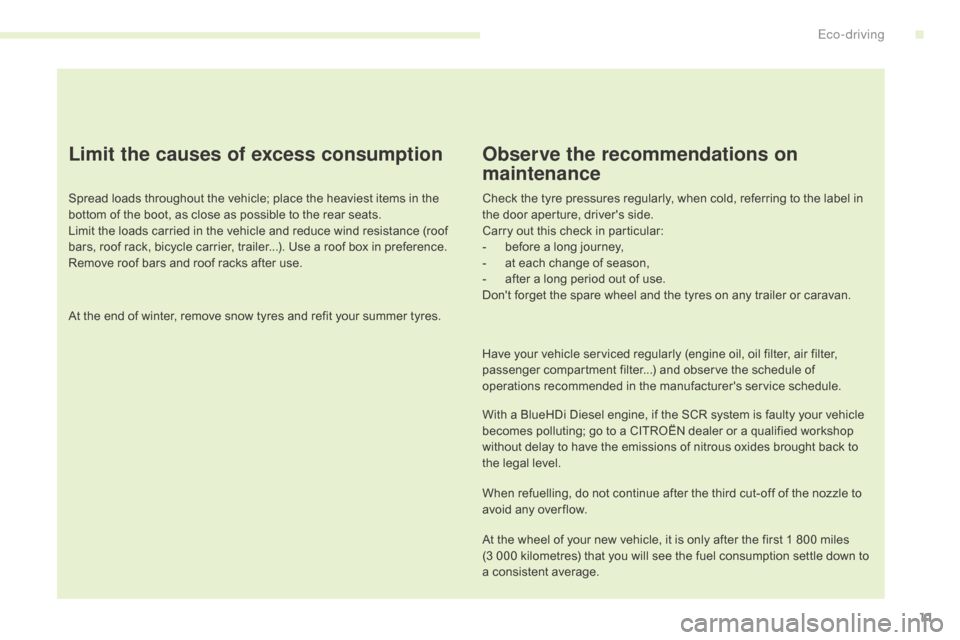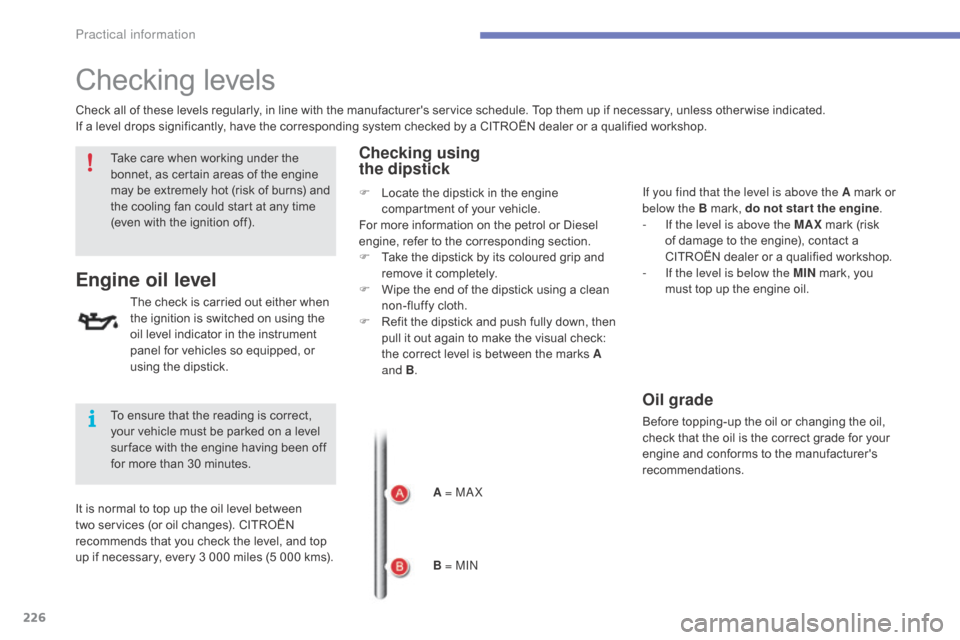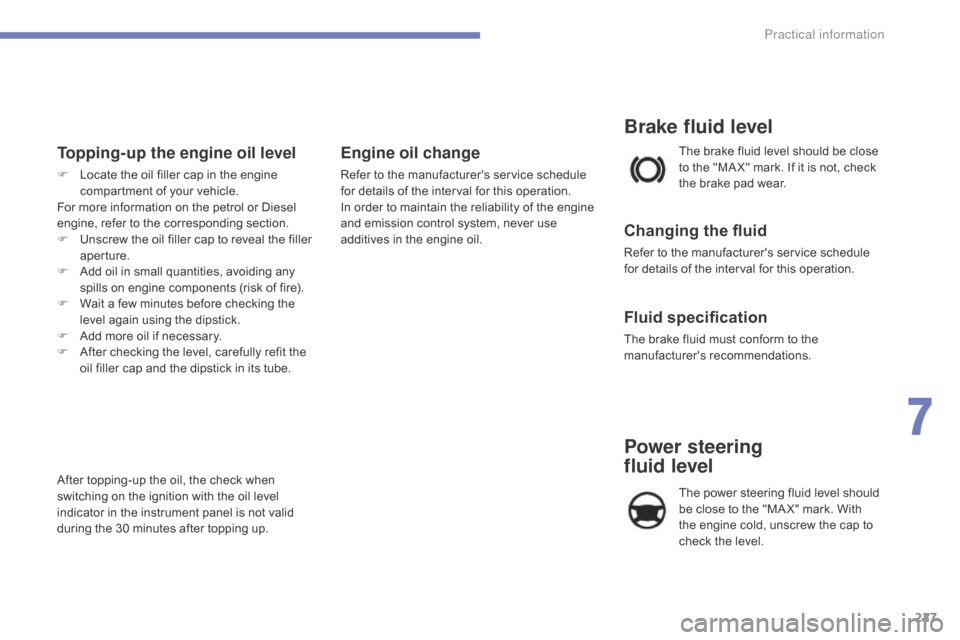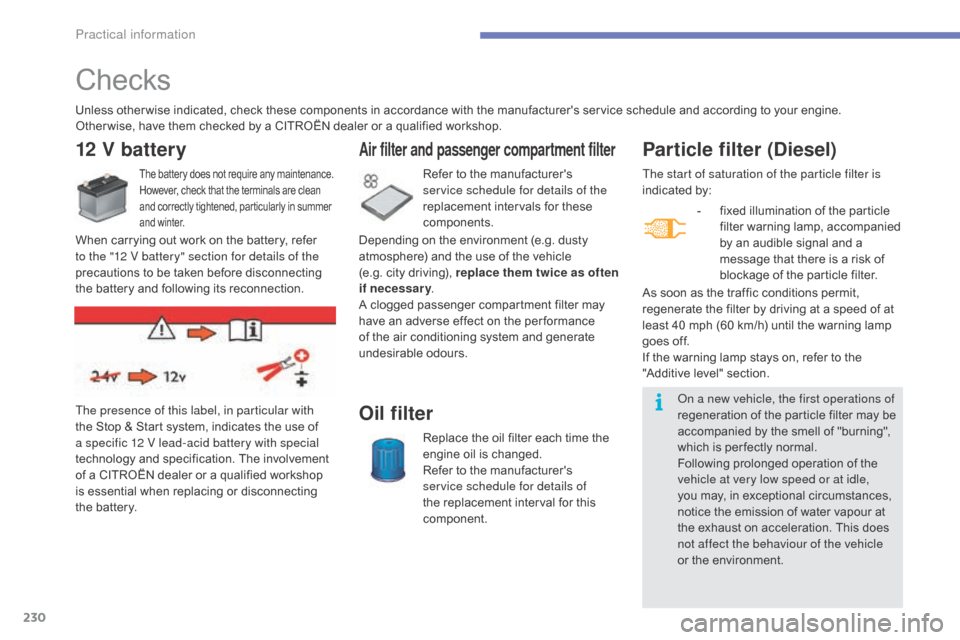service schedule Citroen C4 2016 2.G Owner's Manual
[x] Cancel search | Manufacturer: CITROEN, Model Year: 2016, Model line: C4, Model: Citroen C4 2016 2.GPages: 396, PDF Size: 10.22 MB
Page 13 of 396

11
C4-2_en_Chap00c_eco-conduite_ed02-2015
Limit the causes of excess consumption
Spreadô loadsô throughoutô theô vehicle;ô placeô theô heaviestô itemsô inô theô bottom ô of ô the ô boot, ô as ô close ô as ô possible ô to ô the ô rear ô seats.
Limit
ô the ô loads ô carried ô in ô the ô vehicle ô and ô reduce ô wind ô resistance ô (roof ô
b
ars, ô roof ô rack, ô bicycle ô carrier, ô trailer...). ô Use ô a ô roof ô box ô in ô preference.
Remove
ô roof ô bars ô and ô roof ô racks ô after ô use.
At
ô the ô end ô of ô winter, ô remove ô snow ô tyres ô and ô refit ô your ô summer ô tyres.
Observe the recommendations on
maintenance
Checkô theô tyreô pressuresô regularly,ô whenô cold,ô referringô toô theô labelô inô the ô door ô aperture, ô driver's ô side.
Carry
ô out ô this ô check ô in ô particular:
-
ô
b
efore ô a ô long ô journey,
-
ô
a
t ô each ô change ô of ô season,
-
ô
a
fter ô a ô long ô period ô out ô of ô use.
Don't
ô forget ô the ô spare ô wheel ô and ô the ô tyres ô on ô any ô trailer ô or ô caravan.
Have
ô your ô vehicle ô serviced ô regularly ô (engine ô oil, ô oil ô filter, ô air ô filter, ô
p
assenger ô compartment ô filter...) ô and ô observe ô the ô schedule ô of ô
o
perations ô recommended ô in ô the ô manufacturer's ô service ô schedule.
With
ô a ô BlueHDi ô Diesel ô engine, ô if ô the ô SCR ô system ô is ô faulty ô your ô vehicle ô
b
ecomes ô polluting; ô go ô to ô a ô CITROûN ô dealer ô or ô a ô qualified ô workshop ô
w
ithout ô delay ô to ô have ô the ô emissions ô of ô nitrous ô oxides ô brought ô back ô to ô
t
he ô legal ô level.
When
ô refuelling, ô do ô not ô continue ô after ô the ô third ô cut-off ô of ô the ô nozzle ô to ô
a
void ô any ô over flow.
At
ô the ô wheel ô of ô your ô new ô vehicle, ô it ô is ô only ô after ô the ô first ô 1 ô 800 ô miles ô
(
3ô 000 ô kilometres) ô that ô you ô will ô see ô the ô fuel ô consumption ô settle ô down ô to ô
a
ô consistent ô average.
.
Eco-driving
Page 228 of 396

226
C4-2_en_Chap07_infos-pratiques_ed02-2015
Checkingô levels
Theô checkô isô carriedô outô eitherô whenô the ô ignition ô is ô switched ô on ô using ô the ô
o
il ô level ô indicator ô in ô the ô instrument ô
p
anel ô for ô vehicles ô so ô equipped, ô or ô
u
sing ô the ô dipstick.
Engine oil level
Checking using
the dipstick
Checkô allô ofô theseô levelsô regularly,ô inô lineô withô theô manufacturer'sô serviceô schedule.ô Topô themô upô ifô necessary,ô unlessô other wiseô indicated.
I f ô a ô level ô drops ô significantly, ô have ô the ô corresponding ô system ô checked ô by ô a ô CITROûN ô dealer ô or ô a ô qualified ô workshop.
It
ô is ô normal ô to ô top ô up ô the ô oil ô level ô between ô
t
wo ô services ô (or ô oil ô changes). ô CITROûN ô
r
ecommends ô that ô you ô check ô the ô level, ô and ô top ô
u
p ô if ô necessary, ô every ô 3 ô 000 ô miles ô (5 ô 000 ô kms).A = MA X
B = MIN If you find that the level is above the A
ô mark ô or ô
belo
w the B ô mark, ô do not star t the engine.
-
I
f the level is above the MAX
ô
mark ô (risk ô
o
f ô damage ô to ô the ô engine), ô contact ô a ô
C
ITROûN ô dealer ô or ô a ô qualified ô workshop.
-
I
f the level is below the MIN
ô
mark, ô you ô
m
ust ô top ô up ô the ô engine ô oil.
Oil grade
Beforeô topping-upô theô oilô orô changingô theô oil,ô check ô that ô the ô oil ô is ô the ô correct ô grade ô for ô your ô
e
ngine ô and ô conforms ô to ô the ô manufacturer's ô
r
ecommendations.
Take
ô
care
ô
when
ô
working
ô
under
ô
the
ô
b
onnet,
ô
as
ô
certain
ô
areas
ô
of
ô
the
ô
engine
ô
m
ay
ô
be
ô
extremely
ô
hot
ô
(risk
ô
of
ô
burns)
ô
and
ô
t
he
ô
cooling
ô
fan
ô
could
ô
start
ô
at
ô
any
ô
time
ô
(
even
ô
with
ô
the
ô
ignition
ô
off).
To
ô
ensure
ô
that
ô
the
ô
reading
ô
is
ô
correct,
ô y
our
ô
vehicle
ô
must
ô
be
ô
parked
ô
on
ô
a
ô
level
ô
s
ur face
ô
with
ô
the
ô
engine
ô
having
ô
been
ô
off
ô
f
or
ô
more
ô
than
ô
30
ô
minutes. F
ô
L
ocate
ô
the
ô
dipstick
ô
in
ô
the
ô
engine
ô
c
ompartment
ô
of
ô
your
ô
vehicle.
For
ô
more
ô
information
ô
on
ô
the
ô
petrol
ô
or
ô
Diesel
ô
e
ngine,
ô
refer
ô
to
ô
the
ô
corresponding
ô
section.
F
ô
T
ake
ô
the
ô
dipstick
ô
by
ô
its
ô
coloured
ô
grip
ô
and
ô
r
emove
ô
it
ô
completely.
F
ô
W
ipe
ô
the
ô
end
ô
of
ô
the
ô
dipstick
ô
using
ô
a
ô
clean
ô
n
on-fluffy
ô
cloth.
F
ô
R
efit
ô
the
ô
dipstick
ô
and
ô
push
ô
fully
ô
down,
ô
then
ô
p
ull
ô
it
ô
out
ô
again
ô
to
ô
make
ô
the
ô
visual
ô
check:
ô
t
he
ô
correct
ô
level
ô
is
ô
between
ô
the
ô
marks
ô
A
and B .
Practical information
Page 229 of 396

227
C4-2_en_Chap07_infos-pratiques_ed02-2015
Topping-up the engine oil level
Fô Locateô the ô oil ô filler ô cap ô in ô the ô engine ô c
ompartment ô of ô your ô vehicle.
For
ô more ô information ô on ô the ô petrol ô or ô Diesel ô
e
ngine, ô refer ô to ô the ô corresponding ô section.
F
ô
U
nscrew ô the ô oil ô filler ô cap ô to ô reveal ô the ô filler ô
a
perture.
F
ô
A
dd ô oil ô in ô small ô quantities, ô avoiding ô any ô
s
pills ô on ô engine ô components ô (risk ô of ô fire).
F
ô
W
ait ô a ô few ô minutes ô before ô checking ô the ô
l
evel ô again ô using ô the ô dipstick.
F
ô
A
dd ô more ô oil ô if ô necessary.
F
ô
A
fter ô checking ô the ô level, ô carefully ô refit ô the ô
o
il ô filler ô cap ô and ô the ô dipstick ô in ô its ô tube.
After
ô topping-up ô the ô oil, ô the ô check ô when ô
s
witching ô on ô the ô ignition ô with ô the ô oil ô level ô
i
ndicator ô in ô the ô instrument ô panel ô is ô not ô valid ô
d
uring ô the ô 30 ô minutes ô after ô topping ô up.
Engine oil change
Referô toô theô manufacturer'sô serviceô scheduleô for ô details ô of ô the ô interval ô for ô this ô operation.
In
ô order ô to ô maintain ô the ô reliability ô of ô the ô engine ô
a
nd ô emission ô control ô system, ô never ô use ô
a
dditives ô in ô the ô engine ô oil.
Brake fluid level
Changing the fluid
Referô toô theô manufacturer'sô serviceô scheduleô for ô details ô of ô the ô interval ô for ô this ô operation.
Fluid specification
Theô brakeô fluidô mustô conformô toô theô manufacturer'sô r ecommendations.
The
ô brake ô fluid ô level ô should ô be ô close ô
t
o ô the ô "MA X" ô mark. ô If ô it ô is ô not, ô check ô
t
he ô brake ô pad ô wear.
Power steering
fluid level
Theô powerô steeringô fluidô levelô shouldô b
e ô close ô to ô the ô "MA X" ô mark. ô With ô
t
he ô engine ô cold, ô unscrew ô the ô cap ô to ô
c
heck ô the ô level.
7
Practical information
Page 232 of 396

230
C4-2_en_Chap07_infos-pratiques_ed02-2015
Checks
Particle filter (Diesel)
-ô fixedô illumination ô of ô the ô particle ô f
ilter ô warning ô lamp, ô accompanied ô
b
y ô an ô audible ô signal ô and ô a ô
m
essage ô that ô there ô is ô a ô risk ô of ô
b
lockage ô of ô the ô particle ô filter.
The presence of this label, in particular with
the
ô
Stop
ô
&
ô
Start
ô
system,
ô
indicates
ô
the
ô
use
ô
of
ô
a s
pecific 12 V lead-acid battery with special
technology
ô
and
ô
specification.
ô
The
ô
involvement
ô
o
f
ô
a
ô
CITROûN
ô
dealer
ô
or
ô
a
ô
qualified
ô
workshop
ô
i
s
ô
essential
ô
when
ô
replacing
ô
or
ô
disconnecting
ô
t
he
ô
battery. As
ô
soon
ô
as ô the ô traffic ô conditions ô permit, ô
r
egenerate ô the ô filter ô by ô driving ô at ô a ô speed ô of ô at ô
l
east
ô
40
ô
mph ô (60 ô km/h) ô until ô the ô warning ô lamp ô
g
oes
ô
off.
If
ô
the
ô
warning ô lamp ô stays ô on, ô refer ô to ô the ô
"
Additive
ô
level" ô section.
Unless
ô
other wise
ô
indicated,
ô
check
ô
these
ô
components
ô
in
ô
accordance
ô
with
ô
the
ô
manufacturer's
ô
service
ô
schedule
ô
and ô according ô to ô your ô engine.
Other wise,
ô
have
ô
them
ô
checked
ô
by
ô
a
ô
CITROûN
ô
dealer
ô
or
ô
a
ô
qualified
ô
workshop.
Air filter and passenger compartment filter
Referô toô theô manufacturer'sô s
ervice schedule for details of the
replacement
ô intervals ô for ô these ô
c
omponents.
Oil filter
Replaceô theô oilô filterô eachô timeô theô e ngine ô oil ô is ô changed.
Refer
ô to ô the ô manufacturer's ô
s
ervice schedule for details of
the
ô replacement ô interval ô for ô this ô
c
omponent.
12 V battery
Theô batteryô doesô notô requireô anyô maintenance.
H owever, ô check ô that ô the ô terminals ô are ô cleanô a
nd ô correctly ô tightened, ô particularly ô in ô summer
ô a
nd ô winter.
Whenô carryingô outô workô onô theô battery,ô referô to the "12 V battery" section for details of the
precautions
ô to ô be ô taken ô before ô disconnecting ô
t
he ô battery ô and ô following ô its ô reconnection.Depending
ô on ô the ô environment ô (e.g. ô dusty ô a
tmosphere) ô and ô the ô use ô of ô the ô vehicle ô
(e.g.
ô city ô driving), ô replace them twice as often
if necessary .
A
ô clogged ô passenger ô compartment ô filter ô may ô
h
ave ô an ô adverse ô effect ô on ô the ô per formance ô
o
f ô the ô air ô conditioning ô system ô and ô generate ô
u
ndesirable
ô o
dours.The start of saturation of the particle filter is
indicated
ô by:
On a new vehicle, the first operations of
regeneration ô of ô the ô particle ô filter ô may ô be ô
a
ccompanied ô by ô the ô smell ô of ô "burning", ô
w
hich ô is ô per fectly ô normal.
Following
ô prolonged ô operation ô of ô the ô
v
ehicle at very low speed or at idle,
you
ô may, ô in ô exceptional ô circumstances, ô
n
otice ô the ô emission ô of ô water ô vapour ô at ô
t
he ô exhaust ô on ô acceleration. ô This ô does ô
n
ot affect the behaviour of the vehicle
or
ô the ô environment.
Practical information
Page 233 of 396

231
C4-2_en_Chap07_infos-pratiques_ed02-2015
Automatic gearbox
Theô gearboxô doesô notô requireô anyô maintenance ô (no ô oil ô change).
Refer
ô to ô the ô manufacturer's ô
s
ervice schedule for details of
the
ô level ô checking ô interval ô for ô this ô
c
omponent.
Electric parking brake
Thisô systemô doesô notô requireô anyô routine ô servicing. ô However, ô in ô
t
he ô event ô of ô a ô problem, ô have ô the ô
s
ystem ô checked ô by ô a ô CITROûN ô
d
ealer ô or ô a ô qualified ô workshop.
Manual parking brake
If a loss of effectiveness of this
systemô i s ô n oticed, ô t he ô p arking ô b rake ô
m
ust ô be ô checked, ô even ô between ô
t
wo ô services.
Brake pads
Brakeô wearô dependsô onô theô styleô of ô driving, ô particularly ô in ô the ô case ô
o
f vehicles used in town, over short
distances.
ô It ô may ô be ô necessary ô to ô
Brake disc wear
Forô informationô onô checkingô brakeô disc wear, contact a CITROûN
dealer
ô or ô a ô qualified ô workshop.
For
ô more ô information ô on ô the ô electric ô parking ô
b
rake, ô refer ô to ô the ô corresponding ô section.
Manual gearbox
Theô gearboxô doesô notô requireô anyô maintenance ô (no ô oil ô change).
Refer
ô to ô the ô manufacturer's ô service ô
s
chedule ô for ô the ô checking ô interval ô
f
or ô this ô component.
Only
ô use ô products ô recommended ô by ô
C
ITROûN ô or ô products ô of ô equivalent ô
q
uality
ô an
d
ô sp
ecification.
In
ô order ô to ô optimise ô the ô operation ô of ô
u
nits ô as ô important ô as ô those ô in ô the ô
b
raking ô system, ô CITROûN ô selects ô and ô
o
ffers ô very ô specific ô products.
After
ô washing ô the ô vehicle, ô dampness, ô
o
r ô in ô wintry ô conditions, ô ice ô can ô form ô
o
n ô the ô brake ô discs ô and ô pads: ô braking ô
e
fficiency ô may ô be ô reduced. ô Make ô light ô
b
rake ô applications ô to ô dry ô and ô defrost ô
t
he ô brakes.
have
ô
the
ô
condition ô of ô the ô brakes ô checked, ô even ô
b
etween
ô v
ehicle
ô s
ervices.
Unless
ô
there ô is ô a ô leak ô in ô the ô circuit, ô a ô drop ô in ô
t
he
ô
brake
ô
fluid ô level ô indicates ô that ô the ô brake ô
p
ads
ô
are
ô
worn. Checking
ô this ô system ô must ô be ô done ô by ô a ô
C
ITROûN ô dealer ô or ô a ô qualified ô workshop.
7
Practical information
Page 234 of 396

232
C4-2_en_Chap07_infos-pratiques_ed02-2015
AdBlueôÛô additiveô andô SCRô system
f
or
ô
BlueHDi ô Diesel ô engines
Toô assureô respectô forô theô environmentô andô c
onformity ô with ô the ô new ô Euro ô 6 ô emissions ô
s
tandard, ô without ô adversely ô affecting ô the ô
p
er formance ô or ô fuel ô consumption ô of ô Diesel ô
e
ngines, ô CITROûN ô has ô taken ô the ô decision ô to ô
e
quip ô its ô vehicles ô with ô an ô effective ô system ô that ô
a
ssociates ô SCR ô (Selective ô Catalytic ô Reduction) ô
w
ith ô a ô particle ô filter ô (FAP) ô for ô the ô treatment ô of ô
e
xhaust ô gases.
Presentation of the SCR system
Usingô anô additiveô calledô AdBlueôÛô containingô urea,ô a
ô
catalytic
ô
converter
ô
turns
ô
up
ô
to
ô
85% ô of ô nitrousô o
xides
ô
(NOx)
ô
into
ô
nitrogen
ô
and
ô
water, ô which ô are
ô h
armless
ô
to
ô
health
ô
and
ô
the
ô
environment.
The AdBlueôÛ additive is held in a special
tank
ô
located
ô under ô the ô boot ô at ô the ô rear ô of ô
t
he
ô
vehicle.
ô
It ô has ô a ô capacity ô of ô 17 ô litres: ô this ô
p
rovides
ô
a
ô
driving ô range ô of ô about ô 12 ô 500 ô miles ô
(
20
ô
000
ô
km),
ô after ô which ô an ô alert ô is ô triggered ô
w
arning
ô
you
ô
when ô the ô reserve ô remaining ô is ô
e
nough
ô
for
ô
just ô 1 ô 500 ô miles ô (2 ô 400 ô km).
During
ô
each
ô scheduled ô service ô of ô your ô vehicle ô
b
y
ô
a
ô
CITROûN ô dealer ô or ô a ô qualified ô workshop, ô
t
he AdBlue
ôÛô additiveô tankô isô refilledô inô orderô toô a
llow
ô
normal ô operation ô of ô the ô SCR ô system.
If
ô
the
ô
estimated ô mileage ô between ô two ô services ô
i
s
ô
greater
ô
than ô 12 ô 500 ô miles ô (20 ô 000 ô km), ô we ô
r
ecommend
ô that ô you ô go ô to ô a ô CITROûN ô dealer ô
o
r
ô
a
ô
qualified ô workshop ô to ô have ô the ô necessary ô
t
op-up
ô
carried ô out. Once the AdBlue
ôÛô tankô isô empty,ô aô s
ystem
ô
required
ô
by ô regulations ô prevents ô
s
tarting
ô
of
ô
the
ô
engine.
If the SCR is faulty, the level of
emissions
ô
from
ô
your ô vehicle ô will ô no ô
l
onger
ô
meet
ô
the
ô
Euro ô 6 ô standard: ô your ô
v
ehicle
ô
becomes
ô
polluting.
In
ô
the
ô
event
ô
of
ô
a
ô
confirmed ô fault ô
w
ith
ô
the
ô
SCR
ô
system, ô you ô must ô go ô
t
o
ô
a
ô
CITROûN
ô
dealer ô or ô a ô qualified ô
w
orkshop
ô
as
ô
soon ô as ô possible: ô after ô
a
ô
running
ô
distance ô of ô 650 ô miles ô
(
1ô 100
ô
km),
ô
a
ô
system ô will ô be ô triggered ô
a
utomatically
ô
to
ô
prevent ô engine ô starting.
Freezing of the AdBlue
ôÛ additive
The AdBlue
ôÛ additive freezes at
temperatures ô below ô around ô -11ô¯C.
The
ô
SCR
ô
system ô includes ô a ô heater ô
f
or the AdBlue
ôÛô tank,ô allowingô youô toô c
ontinue
ô
driving ô in ô very ô cold ô conditions.
Practical information